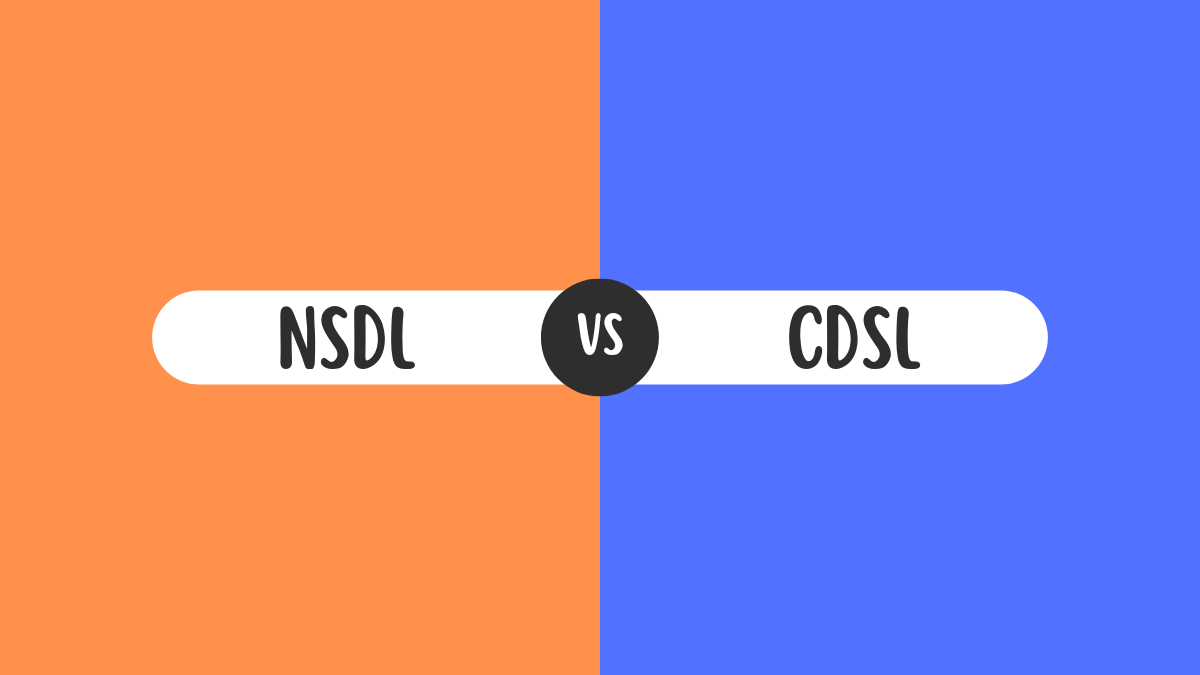In Indian (भारतीय) financial market there are two securities depositories that ensures efficiently and securely hold securities in electronic form and facilitates smooth trading. The first one is NSDL (National Securities Depository Limited) and the second one is CDSL (Central Depository Services Limited).

In this article, we will shed some lights on the difference between them and elucidate their roles, structures, and significance in the Indian financial landscape without using any kind of technical jargon.
Let’s begin with both depository’s introductions.
NSDL (National Securities Depository Limited).
NSDL, established in 1996, is the leader in introducing electronic securities’ depository services in India. It played a very important role in transitioning from physical share certificates to electronic form, bringing efficiency and transparency to the capital market. Now it is very easy to manage securities in just few clicks.
If we see its ownership structure then NSDL is a joint venture between leading financial institutions such as State Bank of India (SBI), HDFC Bank (India’s leading “Private” bank), and Standard Chartered Bank. Its ownership structure reflects a collaborative effort by key players in the financial sector.
NSDL provides a range of depository services, including dematerialization (demat) of securities, maintenance of electronic records, and settlement of trades in a secure and swift manner.
Its extensive network caters to a diverse set of market participants, including investors, depository participants, and issuers. Leveraging cutting-edge technology, NSDL ensures the integrity and safety of securities transactions. The depository employs robust security measures, including encryption and secure access controls, to safeguard the electronic records of investors.
CDSL (Central Depository Services Limited).
CDSL, incorporated and began their services in 1999 at Mumbai. It entered the depository landscape shortly after NSDL as the second largest depository service in the country and rapidly growing now. It emerged as a formidable competitor in the depository space, contributing to the growth and development of the Indian capital market by providing efficient depository services.
If we look into its promotor then CDSL is mostly promoted by leading financial institutions such as the Bombay Stock Exchange (BSE), State Bank of India (SBI), and Bank of Baroda. This collaborative ownership model reflects a diverse representation from both banking and stock exchange sectors.
Similar to NSDL, CDSL offers a comprehensive suite of depository services. These include dematerialization, maintenance of electronic records, and facilitation of secure and prompt settlement of trades. CDSL’s services cater to a wide spectrum of market participants, fostering a seamless securities market ecosystem.
CDSL embraces technological advancements to enhance its operational efficiency. It employs strict security laws to save investor data and maintain the integrity of the securities held in electronic form.
Key differences between NSDL and CDSL.
Let’s understand the distinctions between NSDL and CDSL in the Indian securities’ depository landscape.
1. Ownership and governance.
NSDL operates as a public company, whereas CDSL functions as a private company. Ownership structure and key promotors influences their governance, decision-making processes, and market strategies. NSDL’s ownership is dominated by banks, while CDSL has a mix of stock exchanges and banks as its promoters.
2. Market share and reach.
NSDL, being the first and oldest, commands a significant market share in terms of the number of demat accounts and securities held, thus held a larger market share. However, CDSL has been steadily expanding its market share presence, leveraging technological innovations and strategic partnerships.
Both depositories have extensive networks, but the distribution of their clientele may vary.
3. Technology platforms.
Both depositories NSDL and CDSL employ advanced technology to ensure secure and efficient transaction processing. However, they may differ in their service offerings, infrastructure, technology integrations, user experience, and interface, catering to distinct segments of investors and intermediaries.
4. Promoter influence.
The influence of promoters, such as stock exchanges or banks, can shape the strategic direction and policies of the depositories. Understanding these influences provides insights into the depositories’ priorities and approaches. I see CDSL as the mass attractor so most active one, while NSDL as default for non-active things.
Conclusion.
In the intricate web of India’s financial markets, NSDL and CDSL stand as integral pillars, facilitating the seamless and secure functioning of the securities’ depository system.
While both entities share common objectives, their differences in ownership, governance, and operational nuances contribute to the diversity and resilience of the Indian capital market. Investors, financial institutions, and market participants benefit from the competition and innovation fostered by these two key players, as they collectively contribute to the growth and evolution of India’s financial ecosystem.
Understanding the distinctions between NSDL and CDSL is more important than anything else for anyone navigating the complexities of the Indian securities market.
Leave a Reply